How to write the product manager resume
Covers PM resume fundamentals and how to make it stand out.
|
|
|
Purpose and audience | Writing and design tips | Examples and critiques
Searching for jobs is intense, stressful, and emotional. For those seeking to break into product management, it can feel like your energy is behind too many arrows, because the field is broad and competitive. This can be discouraging, but don't worry — it's normal. With focus, strategy, and commitment you'll get that dream job.
Let's take the first piece of the journey, the product manager resume. By breaking down the resume process, you'll understand how to sell your best self and discover a wider funnel of PM opportunities.
At RocketBlocks, we'll cover:
- The purpose and audience of the product manager resume
- Tips for writing and designing a resume
- Examples of resumes and critiques
Searching for product manager jobs as a newbie

For those early in their career and looking to break into PM, you're likely targeting a junior or associate role. Here are three common paths to break into PM:
- Associate Product Manager (APM/RPM) program — usually small classes with formal PM training that funnel into entry-level PM roles.
- Junior PM role in a smaller company — usually paired with more senior PMs to manage a scoped product area.
- Internal transfer — depending on transferrable PM skills, may lead to either of the above or standard PM levels.
A common denominator to all 3 paths is a need to sell yourself on paper and get your foot in the door for an interview. Be conscious of the path you're on and prioritize your time accordingly. For example, if you're an internal transfer and can speak to the hiring manager directly — the product manager resume may not be the highest impact investment for your success. However, if you're cold applying to a junior PM role — the resume review is a must-win.
How does a product manager resume help recruiters? (Top)
To win the resume review, we must understand the problem to be solved for all audiences. In this situation we have two personas: the company and the applicant.
Companies want to hire the best fit from the applicant pool. Resumes enable them to:
- Filter for credible applicants via credentials & experience.
- Filter for great communicators who write well.
- Increase their ROI per interview.
Good companies with great opportunities draw impressive applicant demand. The majority of applicants are screened out at the resume step, placing a greater importance on making it your best. Google's APM program is estimated to have a 0.55% acceptance rate. This can provide companies the justification to expect a standout resume from their incoming PMs and only allow a small portion of applicants to pitch themselves in person.
This is an opportunity for applicants as well. Resumes enable you to:
- Establish your unique credibility. You don't need to be an Ivy grad or entrepreneur to land a PM role, but you do need to stand out with transferable PM skills or the capacity to grow into them.
- Drive the reader to have FOMO if they don't interview you. The best resumes tell an unfinished story and paint the picture it can continue with success in your company.
- Prime interviewers for a conversation about your skills. Your resume is useful even past the initial screening; it can be your companion and provide talking points throughout interview loops as well.
The product management resume is an opportunity to submit your highlight reel. Like a highlight reel, it should tell your story and make it look so good anyone would regret not at least having a conversation to learn more.
Read more related pieces about how to prep for interviews as a product manager here:
- Three key ways to prepare for PM interviews
- PM interview prep next steps
- Success metrics PM interview questions
- Cracking PM behavioral interviews
Who is your audience?
In most companies your product management resume will pass the desk of multiple people. As an aspiring PM progresses through the interview process, the focus shifts from your credibility on your resume to your capability through interview performance. This is triggered by the availability of more data as you interview.

The target audience you should prioritize is the recruiter screen.
- Recruiters — they determine if you can begin the interview process. They are usually looking for a signal, that you can become a great PM. This often manifests as an upward trajectory of experiences and responsibility, so tailor a story of growth.
- Interviewers (PMs, designers, engineers, data scientists, etc.) — they determine your capability to act as a PM on the team. Your resume will prime them ahead of meeting you, but interviewers are usually busy with a day job — so make it easy to grok.
- The hiring manager — this person is usually your manager and is determining if you are a match for a high-investment relationship. Your resume should give you solid footing to make a lasting memory as someone who is scrappy, intelligent, and great to work with (key traits for aspiring PMs in place of direct experience).
An x-factor audience may be a computer. Application tracking systems (ATS) may be applied by some companies to filter preferred resumes based on keywords. I do not recommend gaming these systems by plugging invisible text or shoveling buzzwords in. Your story telling and prose should naturally overlap with the preferred qualifications.
Find out what they're looking for (pain points)
How does it feel when you get a telemarketing call and all you hear is a scripted and generic pitch? You’re probably rolling your eyes right before you cut the call. Your recruiter will have much the same reaction if you send them the same resume template you sent to 100 other companies.
Problems and obstacles are unique to each organization. Once you understand the pains of the company you’re applying to, you can customize your resume to fit the organization. PMs are paid to solve problems, so your resume should show that you’re that kind of person.
It may be difficult and time-consuming, but spending a couple of hours conducting your research to hone your pitch can save you more time than in the long run, job-hunting.
Starting your resume from scratch: write everything down
In your first draft, just write out every PM-related experience, accomplishment, and award to build out a resume prototype. Don’t focus on making it look pretty with formatting or length. Just pour everything out, even stuff you don’t think matters. If your first draft is perfect, then you’re doing it wrong.
You can even mention situations that may not be exactly in your professional life, but demonstrate a knack for leadership, initiative, and resourcefulness outside which you can connect back to your pitch – giving recruiters a unique and compelling story on how you’re a natural.
After you’re done fleshing out your product manager-related saga, it’s time to create a narrative that helps trim your prototype down to a highly relevant resume for your company of interest.
Fine-tune the resume to fit your narrative: Every word counts (Top)
Now that we understand the problem to be solved and defined our audience, it's time to write a great story. The narrative you create should intentionally show growth and highlight your problem-solving skills.
First, target your story to show you either already have the skills of a PM or you are capable of growing into them. Common PM needs include:
- Product sense & intuition — does this person understand great vs, good products and what makes that distinction?
- Ability to execute — can this person enable teams to get things done quickly and efficiently?
- Effective communication & cross-team collaboration — can this person translate needs of varying audiences in concise and understandable ways?
- Domain understanding* — this is not always a requirement, especially for junior PMs. However, if your target company is building developer products, then you should show an interest and basic understanding, so you can speak the language of your team and customers.
- Tenacity and grit — will this person find a way to make great things happen if short on resources or direction?
You want to write out this full-fledged story like a short essay, again, in a manner that demonstrates growth and development from initiative and intelligent planning. Below is an example from Clement Kao, co-founder of Product Manager HQ.
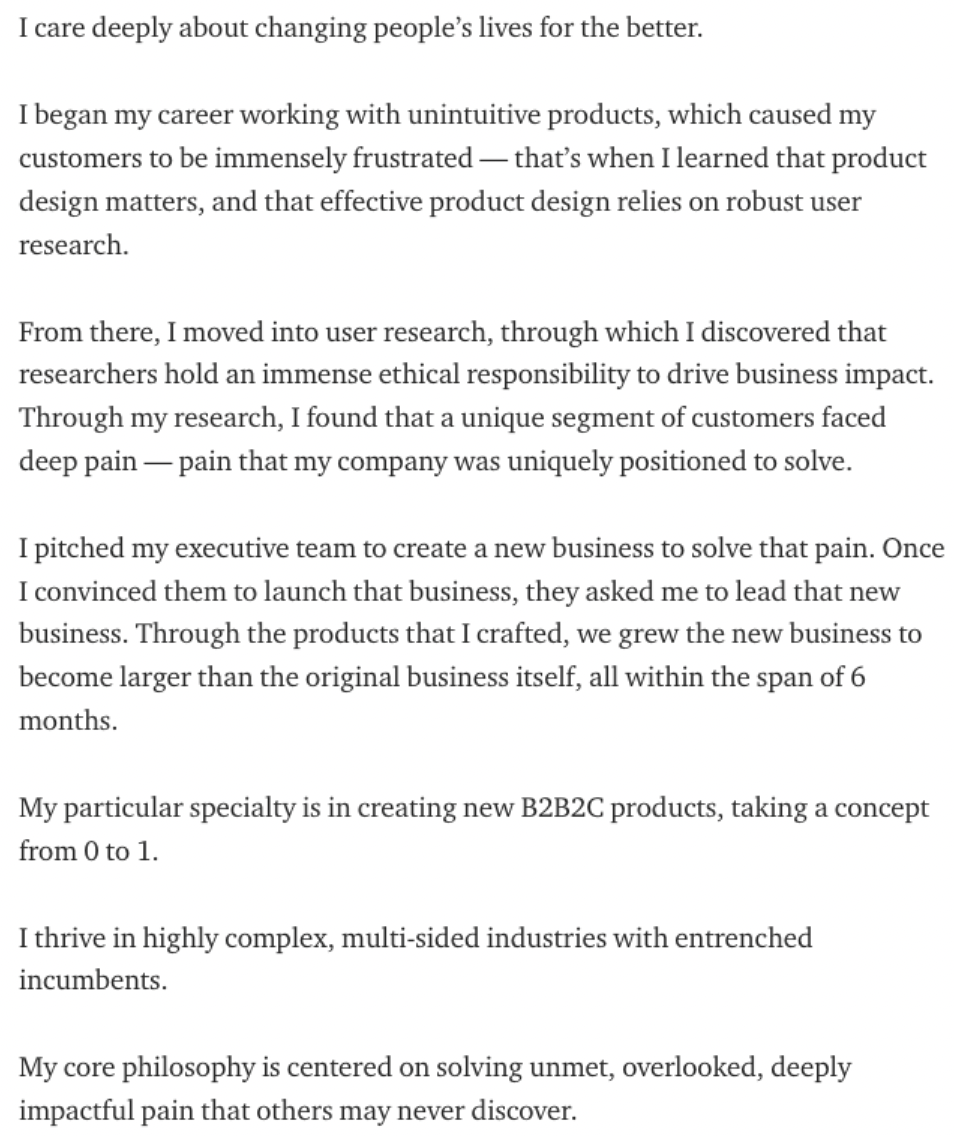
Then, you’ll want to go back to your resume prototype and delete all the experiences and accomplishments that don’t relate to your narrative. Double down on the relevant stuff and follow the tips outlined below to deliver them compellingly.
💡 Got a PM interview? Our PM interview drills help get you in top form
Tips for developing content:
- Numbers are universal. Driving $80M of incremental revenue or 100K new monthly active users is easy and quick to understand impact.
- Show your impact. Be the catalyst. Write in terms of what you've specifically accomplished, not what your task was.
- Less is more. Stick to one page. Blaise Pascal famously wrote: I would have written a shorter letter, but I did not have the time. Take the time to be concise so every word adds value.
- Unconventional experience works. Don't limit yourself. If you created an open-source project, then explain why you built it. If you ran online ads for your neighbor's small business, then show the business value of it. Passion projects are one of the highest ROI investments an aspiring PM can pursue.
- Build honest credibility. Avoid buzzwords. Showing how a seemingly-unrelated experience can be applied to a PM role builds a story.
Making your PM resume ATS compliant
As mentioned above, you don’t want to force-stuff your resume with blanket buzzwords that don’t fit. But, you can articulate your impactful and unique experiences with relevant keywords that tell your story while getting on recruiters’ radars.
Remember that there are dozens of industries and jobs for product managers, from healthcare to finance to tech, to name a few. So the correct language will vary from one job posting to another.
That said, here’s a list of some common product manager resume keywords that you can drop in if the right opportunity arises:
Leadership:
- Set product direction
- Aligning stakeholders
- Presenting to executives
- Leading go-to-market
- Sprint planning
Strategy:
- Building a product roadmap
- Aligning product vision
- Assessing competitive products
- Conducted a strategic review
- Setting team budgets
Product-building:
- Product design
- Prototyping
- A/B testing
- UX/UI design
- Created wireframes
If you're looking for more keywords to include, this post highlights 40 product management keywords that recruiters are looking for.
Designing: You have 6 seconds to pitch
On average, recruiters decide to move forward or decline a resume within 7.4 seconds. Your reader has very limited time, so the sooner you land your pitch the better.
Tips for designing the resume:
- Lead with the punchline. Resume screening means the first bullets determine if your resume gets extra read time or is deferred. When ordering bullets in job sections and deciding what to include, prioritize the information-dense statements to be read first. This requires succinct bullets of what you did and the impact behind your actions.
- Use white space as a reading guide. Dense pages don't get read, easy-to-read ones do. Be generous in spacing, and rely on bullets over sentences.
- Use color sparingly. It can add a flare to pull your resume out of a pile, but it can also distract from the point of your resume — your story and experience.
- Don’t try and be the unicorn with a cursive font – the only way you’re standing out is by getting on the recruiter’s bad side. While you don’t have to stick to Arial or Times New Roman, don’t pick a font that’s illegible, choose a font that's still really easy to read.
- Don’t overlook adding a skills section. Recruiters can value technical skills highly alongside your education and experience. And, you’ll have a less chance of being ignored beside the resumes that do have one if you choose to skip it.
PM resume examples (Top)
To illustrate the points above, let's review four resumes covering areas of opportunity and areas of strength. I've included the original resumes and placed markings to highlight the good areas in green, opportunities to improve in yellow, and areas to avoid in red text.
Case #1: Needs work — Senior PM
This resume has many years of experience that likely had high impact, but it misses the mark on being clear about what their specific impact was.
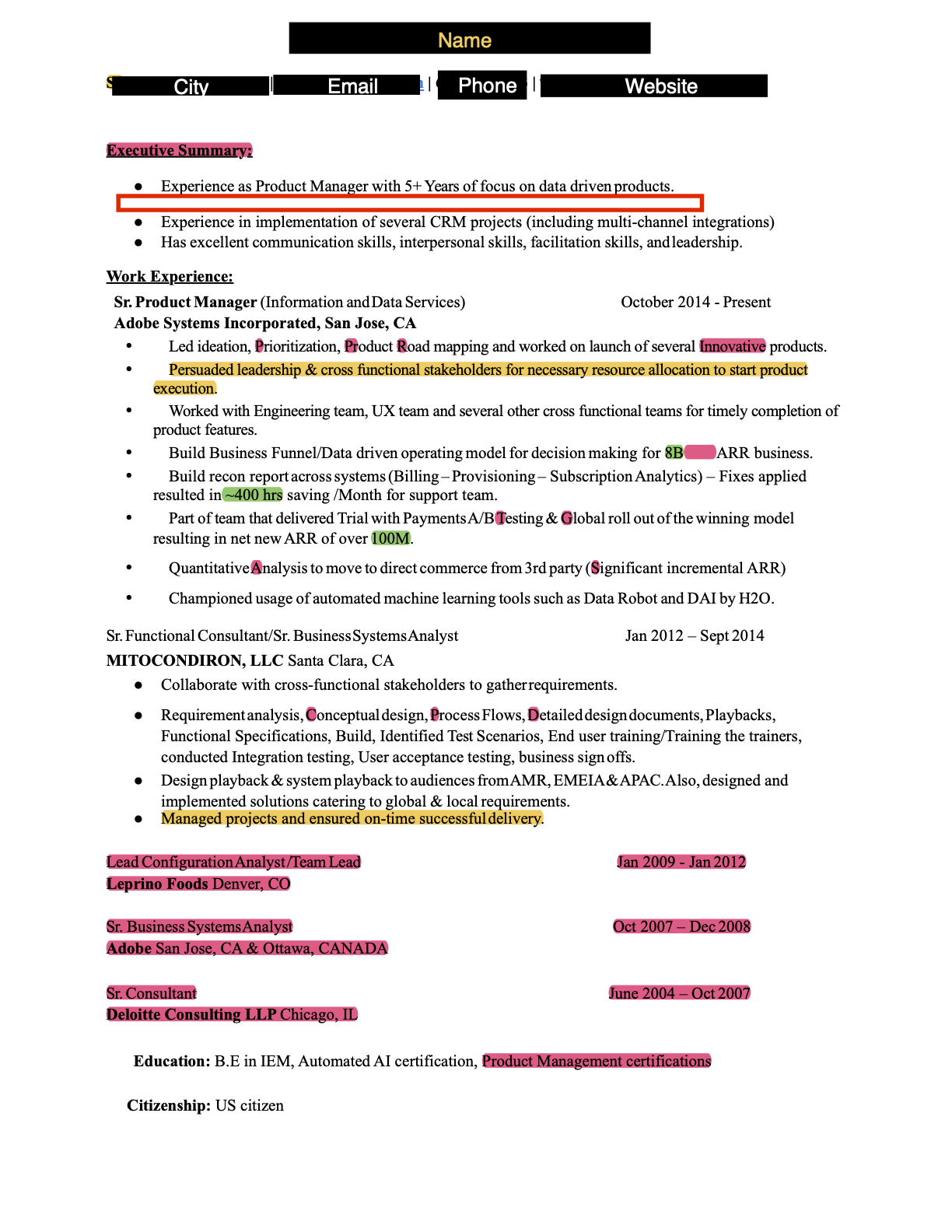
The good:
- Tip #1 (Use Numbers): Some impact was quantified in ARR (8B) and hours saved (~400). To make it even better, quantify the revenue impact to ARR from the operating model. If you can clearly communicate the impact of your direct projects, it implies a data-driven approach to how you invest in work. For the 400 hours saved per month, your reader doesn't have a frame of reference for the magnitude of improvement, so consider percentage improvements when applicable.
Suggestions:
- Tip #1 (Use Numbers): Reorder the bullets which have a quantified impact of what you did to the front. Numbers can communicate more efficiently and convince someone to continue reading.
- Tip #2 (Show Your Impact): Rewrite generic bullets to showcase your specific contribution. Example: instead of "persuaded leadership for resources" consider "landed 5 engineers by pitching new product line to VP resulting in 10x usage in 6 months".
- Tip #3 (Less is More): Remove the executive summary; a 1-page resume shouldn't need it.
- Tip #5 (Honest Credibility): Remove lines which convey subjective competence like "launch of several innovative products". Find ways to show your work was innovative through customer statements or industry acknowledgement. Avoid subjective and self-opinion statements.
- Tip #5 (Honest Credibility): Certifications may be useful if their value is understood by your audience, but vague listings like "Product Management certifications" will come off as space filler.
- Misaligned pixels in a product can kill the experience. Same goes for typos and inconsistent formatting in a resume. It is critical to review and proofread your resume. Examples: extra spacing in executive summary bullets, capitalization of "Innovative" and "Product Road", and different bullet sizing in Adobe experience.
- Rely on learning experiences or talking points for jobs limited on impact. It's okay if every bullet isn't a home run, but you should be contributing to your story with every word used. Another option is to rely on an outlink to LinkedIn or online presence for older jobs with less relevant information. Example: empty listings of the last 3 jobs.
Case #2: Good—New grad
This type of resume is common for entry-level PM applicants and has a lot of unrealized potential locked within the design. The breadth of experiences paint this person as a strong candidate for aspiring PM roles. The resume itself is easy to follow and extracts areas of impact.
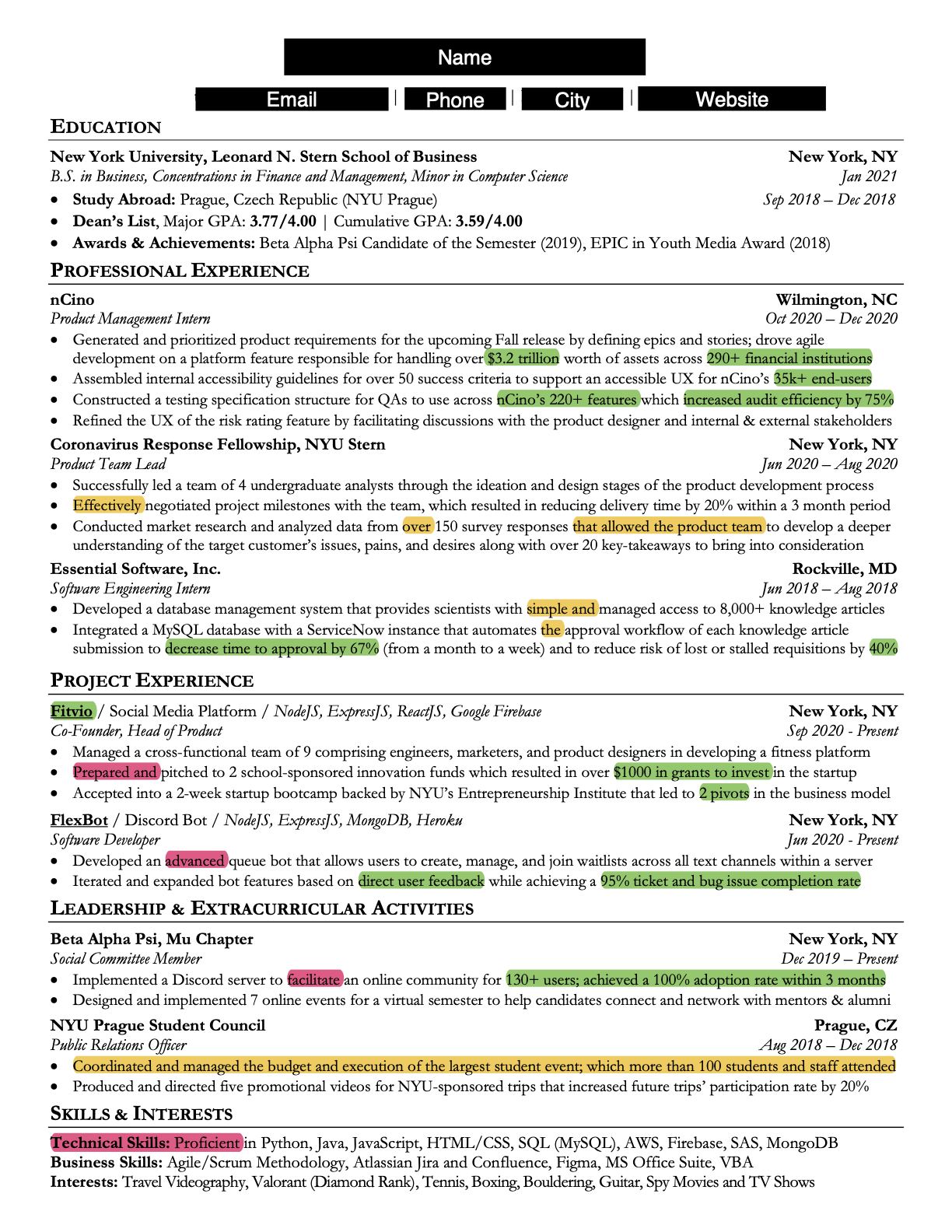
The good:
- Tip #1 (Use Numbers): Quantified impact with dollar values ($3.2 trillion) and sized customers (35k+ end-users).
- Tip #4 (Unconventional Experience): Experience in relevant world problems can stand out, such as the candidate's Coronavirus fellowship. PMs often see opportunities where others see dead-ends; this experience paints the picture of someone looking to tackle big challenges and believing they can do it.
- Tip #5 (Honest Credibility): One of the highest value PM signals is experience in launching a product (Fitvio). It shows ambition and time spent moving an idea into reality with other people. This is a great talking point and worth highlighting in the resume, regardless if it's a digital or physical product/service.
- Effective use of verbs and summarizing what they did in each project so it is easy to understand. Example: "Constructed a test spec infrastructure for QAs across 220+ features increasing audit efficiency 75%",
- A common theme of coordinating large groups of people and leveraging technology to solve problems across experiences.
- Ordering of experience, projects, and extracurriculars is good. The most relevant parts of their story are front and center in a recent PM internship.
Suggestions:
- Tip #3 (Less is More): Remove filler words. The resume is dense and verbose in places where that space is better used with succinct impact. Example: "Prepared and pitched" can simply be "Pitched". "Discord server to facilitate an online community" can be "Discord server for 130+ users".
- Tip #3 (Less is More): Redundancy in listing technical skills and the languages/frameworks used in projects. Can you convey your technical competence with just one? Take caution when listing proficiencies in technical stacks. The depth of topics listed like AWS are massive, so be prepared to discuss them in-depth and defend your statement.
- Tip #3 (Less is More): If your PM internship proved you can coordinate a group and execute, then your student council experience in 2018 might not add sufficient value versus more spacing so it's easier to read.
Case #3: Alternative format—industry PM
As companies move to online submissions, an online presence can offer a fresh way to pitch yourself on top of showing some creativity. The next case is a Notion resume by Shawn Farsai.
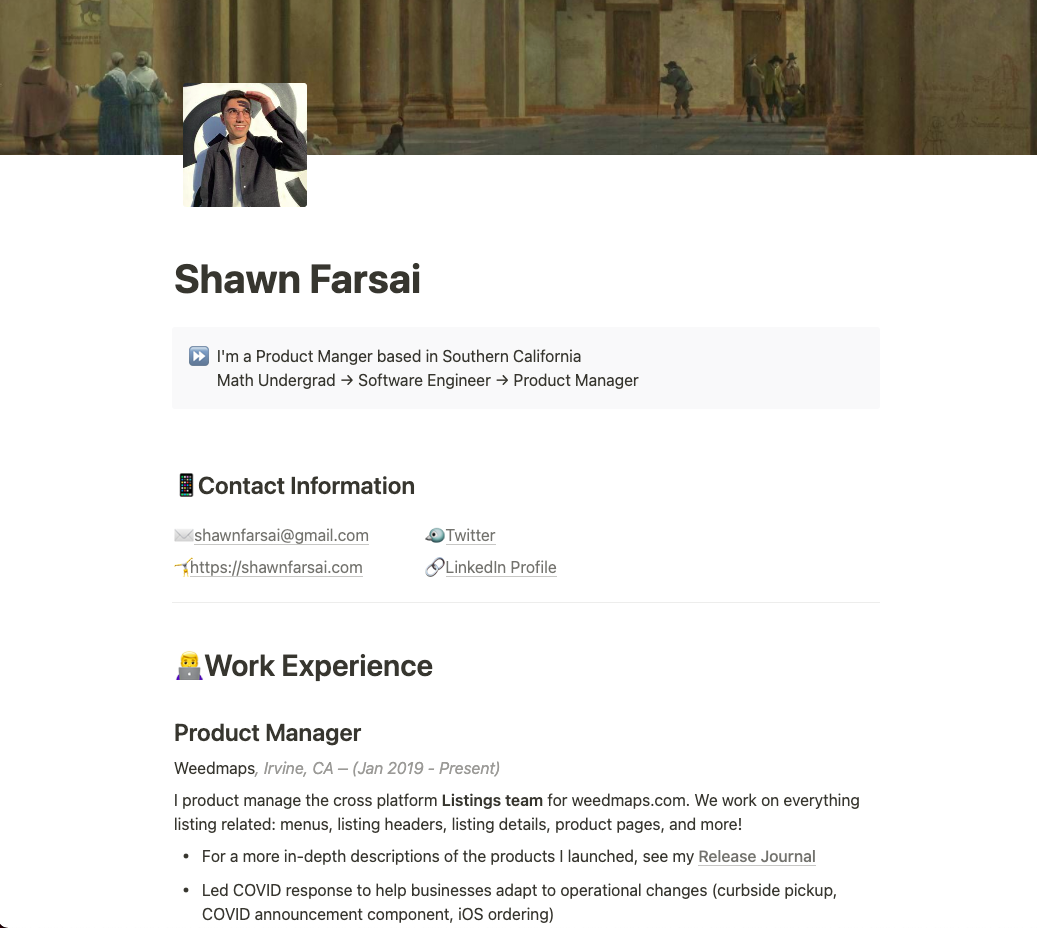
The good:
- Tip #2 (Show Your Impact): The release journal is very valuable; you could bring it more front and center or merge its content into the resume.
- Tip #5 (Honest Credibility): Website resumes are unique and show creativity. A huge benefit is that they remove the design constraints of a single page PDF, offering a chance to convey information in new ways. Make sure the juice is worth the squeeze.
- Ordering of resume sections shows a clear and intentional growth path from SWE to PM.
Suggestions:
- Tip #1 (Use Numbers): Quantify impact with universal understanding. "Making filtering 25% more efficient" doesn't translate clearly to a general user, because we don't understand how filtering is seen as efficient. Consider an alternative like a user-centric conversion metric showing the filtering helps users complete their intended action. If the efficiency was technical, then select a representative efficiency metric like P50/P90/P99 improvements.
- Tip #3 (Less is More):Condense SWE and SWE 3 sections into one story about what you did, learned, and how the learned skills transitioned into PM.
- Edit bullets to get to the point faster; ditch the blog prose. The sentences of Sales/Marketing features could become one statement like "Shipped x,y,z through sales calldowns to unblock $revenue at the cost of %conversion resulting in %increase in Q2 revenue goals". Trade-off questions are great talking points in interviews as well.
- Consider making your online PM portfolios similar to a design portfolio. Find ways to showcase real products/changes you made or great requirement documents you've made.
Case #4: Great—junior PM
The final resume we'll review is a strong example which executes on most of the writing and design tips mentioned above. This candidate successfully landed a PM role at Microsoft and started the Google APM process.
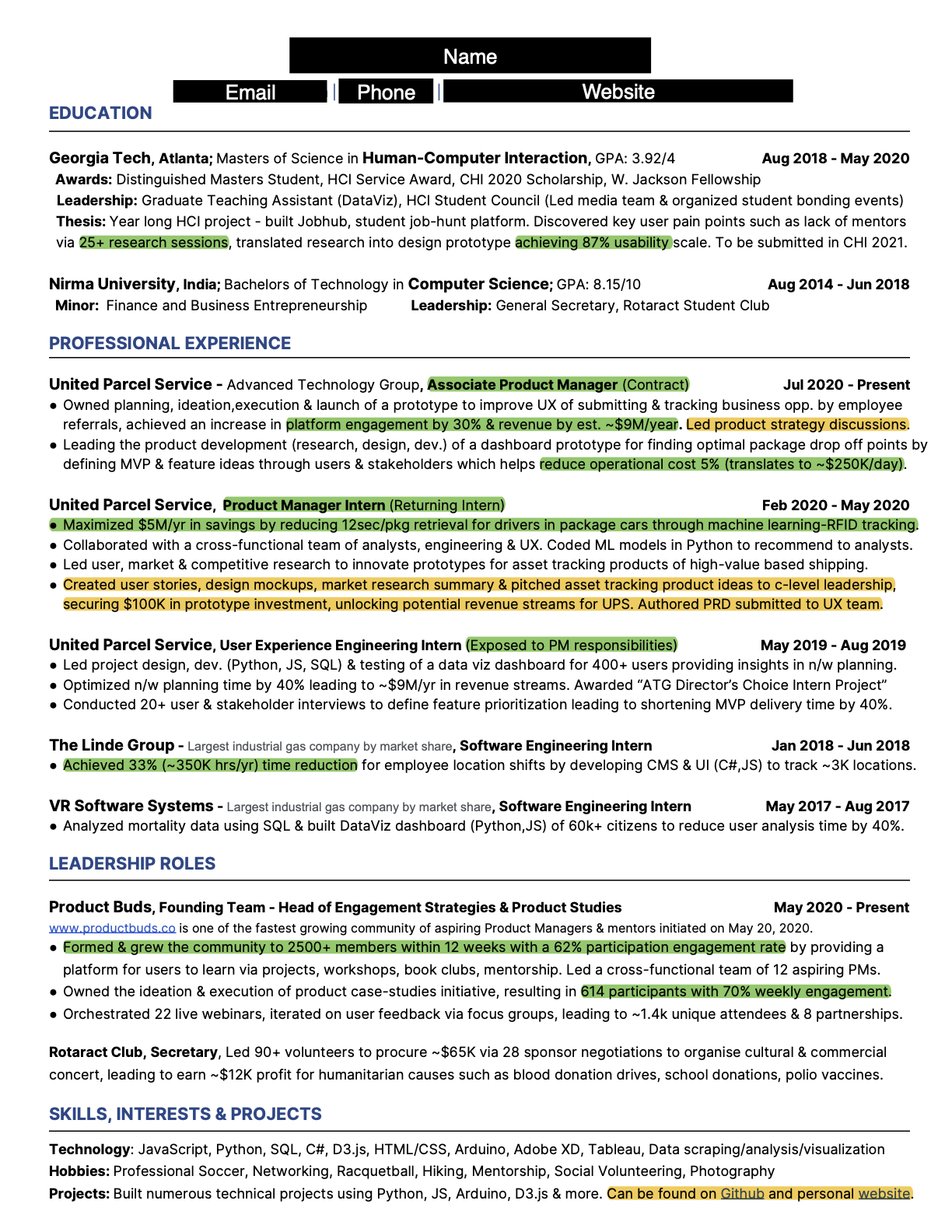
The good:
- Tip #1 (Use Numbers): Most lines in the resume contain quantified impact driven from the candidate's actions. A great example in the resume is "Maximized $5M/yr in savings" by doing action X which succinctly summarizes a result of an action taken. Further details can easily be asked by interviewers as well.
- Tip #2 (Show Your Impact): Many bullets reference actions taken by the candidate instead of stating things a team could vaguely have accomplished without a PM. A solid example of this is "Created user stories...unlocking potential revenue streams for UPS." A potential way to improve this would be to lead with the impact such as "Secured $100K from C-level leadership by pitching a new product line backed by market research & high-fidelity mockups."
- Tip #3 (Less is More): This resume also does a great job of showing a narrative of growth and including succinct accomplishments in early software engineering roles. Work listed at The Linde Group and VR Software Systems show brief impact, but serve their purpose of adding to a narrative of growth and a technical background.
- Tip #5 (Honest Credibility): The narrative behind this resume follows a great trajectory of building competence as an engineer and transitioning into PM laterally within UPS. We can see their accomplishments get larger over time which adds credibility in their path to gaining experience and their potential to contribute as a junior PM.
- Another great aspect is the readability of this resume. There is a wealth of information held in here, but it does not feel overwhelming to browse for content. Even if I only read the bolded words, I can still grasp the narrative of growth across multiple roles and experiences.
Suggestions:
- A potential opportunity lies within their Github and website which are listed last. If you have an open-source project with a handful of stars or even small commits to a large open-source project, then this can be a great talking point as a self-starter.
- To add some polish, it can improve readability to get one point across per bullet. Usually the value of a short sentence at the end of a bullet is limited, such as "Led product strategy discussions."
- Overall the resume is strong and paints a history of intentional learning, growing scope, and passion for product management.
3 must-knows to increase your chances of landing that product management interview
Now that we’ve covered all the basic concepts, tips, examples—and their critiques, let’s finish off with some truths that are known to increase your chances of getting your foot in the door.
- Most recruiters are biased towards hiring product managers with previous experience. In other words, if you’ve held a product management title/job, there’s a greater chance you’d be considered for the position. That’s why in the beginning we recommended breaking into product management with an associate or junior role or through an internal transfer. There’s no better way of selling yourself than showing you’ve been there and done that.
- The best way to ensure your product manager resume gets seen is by passing it through an in-house employee. Instead of letting your carefully-crafted resume sit in a heap of 200 others, you can try building a relationship with an employee in your target company and get them to pass your details forward to the hiring manager or recruiter. In fact, employee referrals boost the odds of a successful job match by 2.6-6.6%.
- Be clear about ownership and initiative. Unlike most resumes and job applications, this isn’t the best time to use phrases like “work on” or “was part of a team that…” You’re not trying to show that you’re a team player (though you are), you’re trying to show that you’re a team manager. So using words like "initiate", "create", "own" and "operate" will turn more recruiters on.
Conclusion: Resumes give what you put in
A deep understanding of the why, who, and what behind resumes can give you a leg up on selling yourself with only a piece of paper or a website. Aspiring PMs often lack direct experience to make their case, so it's even more critical to show their potential through concise writing and crafting a compelling narrative.
A great resume is a signal you know where you've been and where you want to go, which translates across interviews and critical PM skills. A great resume is also never complete, so revisit often and use it as a mirror as you discover the wonderful opportunities ahead of you.
I can't wait to see what the next generation of PMs create, and I'd love to hear if this was useful or other questions you have to grow your PM career. Chat with me on Twitter (@whosjluk) or LinkedIn!
P.S. Are you preparing for PM interviews?
Real interview questions. Sample answers from PM leaders at Google, Amazon and Facebook. Plus study sheets on key concepts.



